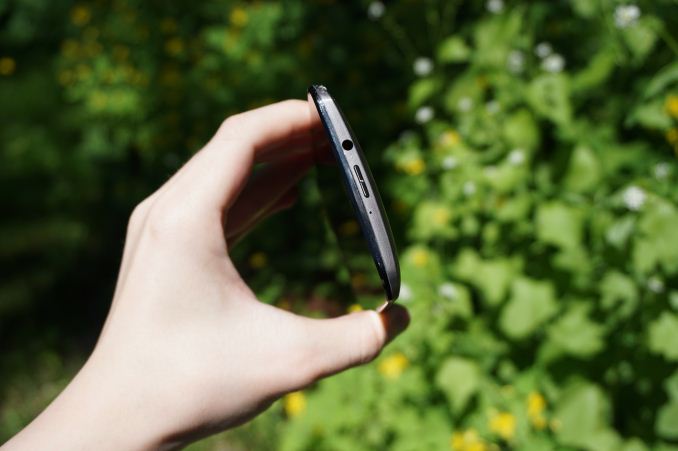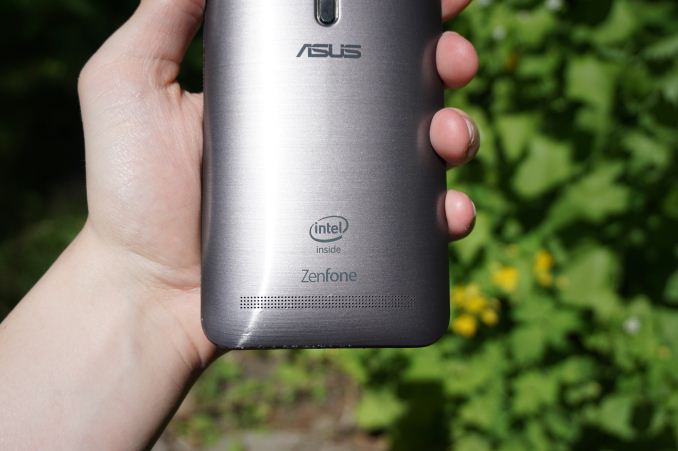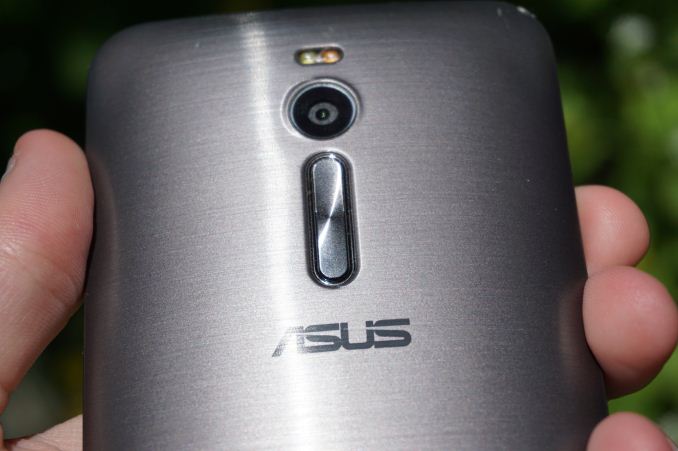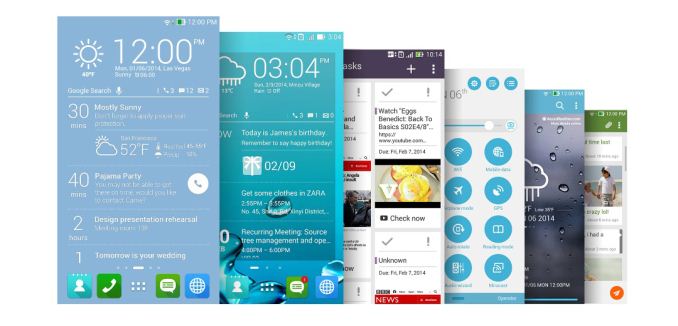The ASUS ZenFone 2 Review
by Brandon Chester on May 26, 2015 8:00 AM ESTFinal Words
Throughout the course of this review you may have noticed that I often compared the ZenFone 2 to high end smartphones like the Galaxy S6, the iPhone 5s and 6, the LG G3, etc. You may have felt that it was unfair to do so, as those smartphones will cost anywhere between two and four times as much as the ZenFone 2 depending on which model of each device you are comparing. In terms of price, the ZenFone 2 is competing with devices like the Moto G and the Lumia 735. You would be right to say that my comparisons have been very unfair. However, I think it says a great deal about the ZenFone 2's quality when the most relevant comparisons are often to devices that cost multiple times as much. It's a compliment toward ASUS and the work they've done to bring a high quality device to such a low price.
When discussing the ZenFone 2, I often find myself reminded of the Nexus 7, and more specifically the second generation model. It makes sense that I would be, as the Nexus 7 was also made by ASUS, and in many ways was similar to the ZenFone 2 in what it hoped to achieve. It had one of the best SoCs you could find in an Android device at the time, a class leading display, and great battery life. It put all of those things into a well built device that was only $219, well below the prices of the competition. The ZenFone 2 feels like ASUS bringing those same goals to the smartphone space. While the ZenFone 2's display isn't quite as good as the second generation Nexus 7 was, it's still very good relative to the price of the phone. That's a statement which can be applied to pretty much every other aspect of the ZenFone 2. In many respects it really does compete with phones that are priced significantly higher than it is.
I think the ZenFone 2 is a very well designed device given the price constraints that ASUS is working within. It has some very nice details like the brushed effect on the back cover, as well as the spun metal look on the volume rocker and on the bottom bezel beneath the display. When you hold the ZenFone 2 it's clearly not an aluminum device, and the finish that ASUS has applied to the plastic back cover doesn't try to trick you into thinking otherwise. But at a visual level it has a very convincing aluminum appearance to it, and I'm surprised that ASUS was able to replicate the reflections that brushed aluminum creates with a plastic back cover. The top mounted power button can definitely be a bit frustrating to use, but it's not the end of the world. The inclusion of double tap to wake on the display also reduces the need to use the power button.
ASUS, with the help of Intel, is really pushing the limits of what a smartphone can be when it has to meet such a low price. The ZenFone 2 offers CPU performance that should probably be creating some concern at Qualcomm, Apple, and Samsung. It's very competitive with the silicon that we see in the most expensive flagship phones available, and both ASUS and Intel should be proud. The SoC's GPU performance competitive with the last generation of flagship devices. While that sounds like criticism, the ZenFone 2's GPU performance is actually well ahead of the other devices that compete with it on price. Intel also handles the throttling of their SoC very gracefully, with GPU performance dropping to a point where it can be maintained for long periods of time rather than repeatedly rising and dropping due to the governor always targeting maximum performance.
While the ZenFone 2 has many positive aspects, it's not flawless by any means. The camera performance is very disappointing. I had really hoped that I would have overwhelming praise for the ZenFone 2's camera, as it's a feature that is so often poorly executed, particularly on inexpensive smartphones. Unfortunately, ASUS still has some things to learn when it comes to camera processing, and whatever processing is being done at the ISP level for videos is really not sufficient. I'm hopeful that the issues with JPEG processing can be addressed in future software updates. The camera is clearly capable of taking some good photos, and if ASUS can find somewhere in the middle of their current camera settings and the Optimization off setting then they'll have addressed one of the few major flaws with their device.
The other big flaw is that battery life is certainly not as good as you would expect from a device with a battery of this size. It's surprising to see such a huge gap in battery life between the ZenFone 2 and the OnePlus One which has the same display size and resolution, and nearly the same battery capacity. The lack of PSR and the relatively inefficient display are the biggest cause of the battery drain on the ZenFone 2, and it was very disappointing to discover this during the course of my use and testing. The ZenFone 2 is agonizingly close to being perfect for its price, but the battery life and the camera performance really let it down.
The last major point of the phone to discuss would be the software. Both the current software and software updates are definitely things that needs to be considered when buying the ZenFone 2. Since ASUS is a relatively new Android phone vendor, it's hard to say whether or not users can expect timely Android updates, or whether they can expect updates at all. I won't pass any judgement in that regard, and owners of ASUS tablets could give some insight into the level of support ASUS provides for their Android devices after launch. More relevant to the experience that users will have right now right now is ZenUI, ASUS's skin for Android.
I've heard some scathing criticism of ASUS's ZenUI, but I actually felt like it brought some useful additions to Android and didn't impede performance. I think some of the genuine improvements that OEM interfaces and modifications bring to Android are often overlooked, like having a battery percentage in the status bar, or re-enabling silent mode in the early releases of Lollipop. ZenUI was also one of the smoothest interfaces I've ever used. It's hard to put it into words, but some of the launcher animations felt much less mechanical than they do on stock Android, and I rarely noticed any slowdown or jank.
While I think ZenUI definitely gets a lot of things right, I don't hold the overall software experience on the ZenFone 2 in such a high regard. Much of this has to do with preinstalled bloatware. ASUS is best known as a PC vendor, and the ZenFone has enough useless preinstalled software to rival the amount you get on a Windows computer. It ranges from useless apps like the Mirror app which just turns on the front facing camera, to what is quite frankly shovelware like "50+ Games!" and "Clean Master". I feel somewhat bad though, because the deals to include these apps might be one of the only ways that the phone makes ASUS any money.
I suppose that the final question boils down to whether or not the ZenFone 2 is worth buying. Despite its flaws, I would say that the answer is yes for both models. However, I think it's important to make the right decision about which model you purchase, as the higher end SKU costs 50% more than the entry level one. I don't think the faster max CPU clock on the high end model is really worth considering, and while the 4GB of RAM is something that you can brag about, Android functions perfectly well with 2GB or 3GB of RAM.
I think the most important considerations are actually the BoostMaster charger, and the amount of internal NAND. If you like using a high brightness, or if you frequently use your phone in high display APL scenarios such as web browsing, you're going get less than stellar battery life. Having the ability to charge the phone quickly helps to offset the battery frustration. Buying a fast charger like the Motorola Turbo Charger separately is going to set you back around $35, and at that point it may be worth it to just invest in the $299 model. If you need more than 16GB of storage then the $299 model is definitely the one to buy. If you're okay with slower charging or have a faster charger already, and 16GB is enough for you, then I think the $199 model is a great purchase.
To wrap things up, I'll say that I think the ZenFone 2 is now the device to beat at both of its price points. I think most users who are interested in a phone like the ZenFone 2 will opt for the $199 model, but the $299 model also presents a great value for users who want the higher end specs and the incredibly fast charging. I don't really know where the competition in this part of the market will go, as it's hard to imagine that ASUS or any other vendor could possibly provide even better specs or more features at this price point. ASUS definitely has a great product on their hands, and now that it's available worldwide, users will soon be able to experience it for themselves.















147 Comments
View All Comments
meacupla - Tuesday, May 26, 2015 - link
There was another reviewer who also droppped his zenfone 2 and he cracked the screen.So is the phone hard to hold while pulling out of pockets and fingering buttons or what?
niva - Tuesday, May 26, 2015 - link
It's always a risk when you don't use a case, even with a case it can happen.I found most disappointing about this phone the references to zenUI and the pre-installed bloatware. We knew the camera wasn't perfect but had some good parts too already so I wasn't too surprised.
Glock24 - Tuesday, May 26, 2015 - link
Would a metal (alumunium) or glass phone fare any better? Would it also get big scratches and marks?niva - Tuesday, May 26, 2015 - link
Metal doesn't necessarily fare better, though in this case it seems like it would have. Metal can get scratched and unlike this plastic removable case cannot be replaced... also metal is more rigid usually which leads to higher rates of cracked screens though that statement is hard to back up by statistics. Other polycarbonate phones (like Nokia) fare amazingly well in drops and feature surfaces that don't get scratched easily unless you purposely take a knife to them. I for one have never understood the premium materials thing going on in the industry because I always put cases on my phones. Even the all metal phones need cases to help protect them in drops.Frenetic Pony - Thursday, May 28, 2015 - link
I've never dropped my phone in my life, going on 6+ years now for that record, so I've never seen a need for a case. But maybe I'm overconfident, and then maybe so are other people.ketacdx - Tuesday, May 26, 2015 - link
I dropped my first Zenfone 2. Ended up needing to buy a 2nd one (I got the TW models so I've had it for a few weeks)tipoo - Tuesday, May 26, 2015 - link
Plastic phones generally do better in drop tests than metal or obviously glass ones. I have heard of some ZP2s cracking, but I hope it's just the usual odd accident that would put any phone down. I wonder if there are any drop tests of it out yet.Brandon Chester - Tuesday, May 26, 2015 - link
No I was just trying to hold it in my left hand while trying to photograph it. I never dropped it once in normal use, but it's something to look out for. In general I find myself having trouble when holding any phone of this size in one hand, but that's not specific to the ZenFone 2.ketacdx - Tuesday, May 26, 2015 - link
Mine landed flat from about 2-3 feet on my basement cement floor. directly flat on its screen, no sliding or anything and the screen completely shattered. Ironically it didn't have even a scratch elsewhere on it. It was cement so im not necessarily saying the phone is weak however I've dropped phones before but never had anything like that happen. It was very saddening..re2onance - Friday, May 29, 2015 - link
Did you purchase the 550 or the 551. I've heard that the 550 does not actually come with Gorilla Glass 3 which is extremely deceptive in their advertising.